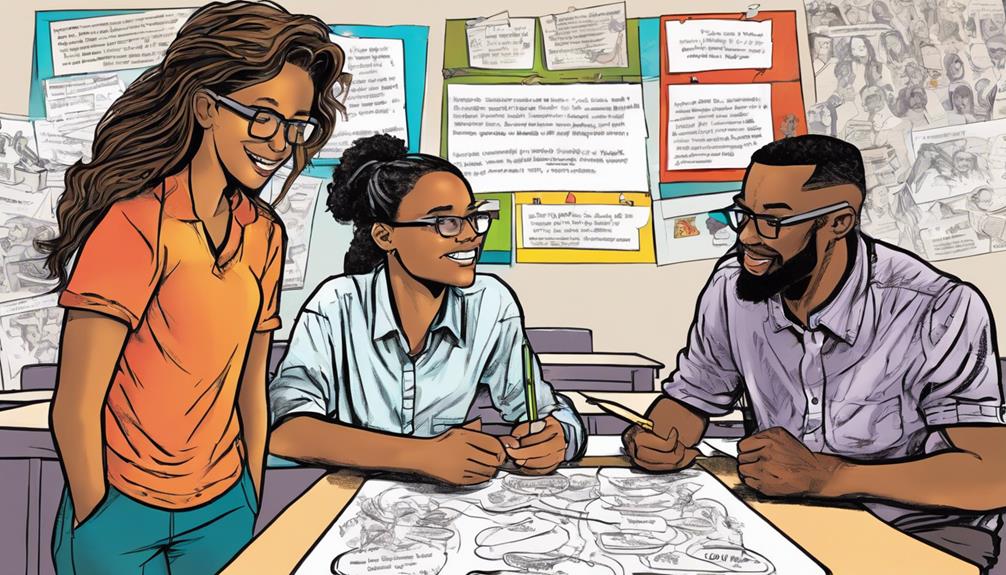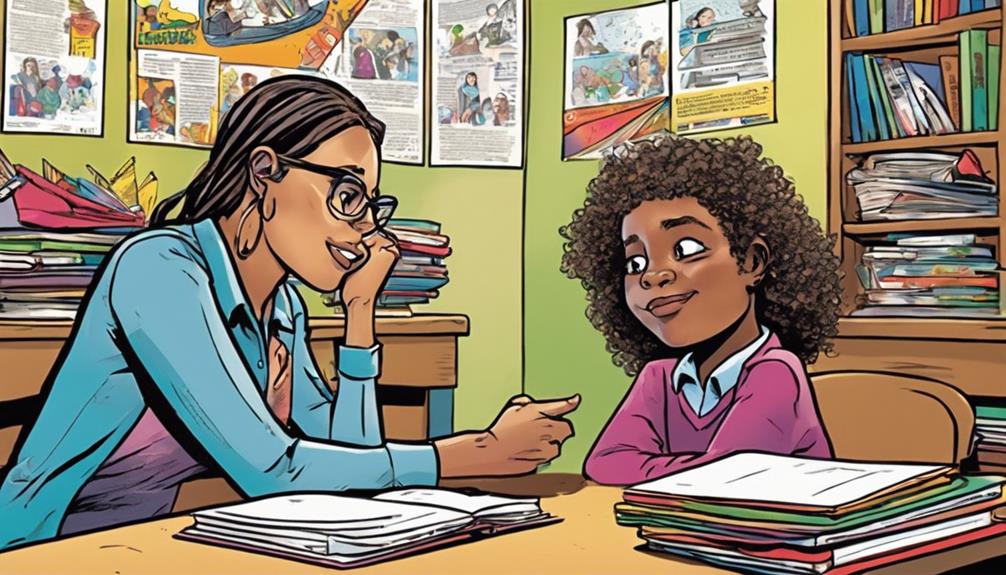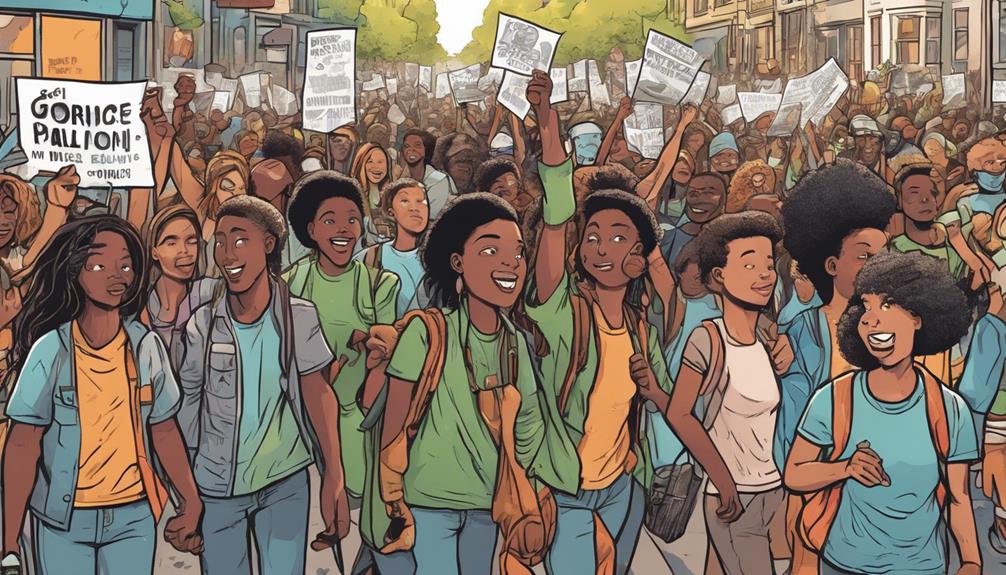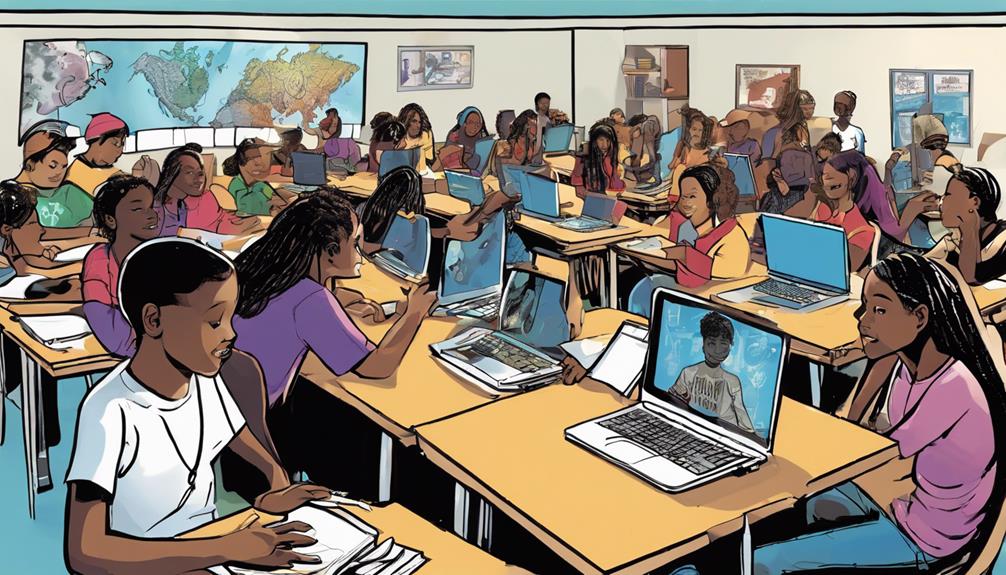Creating a good teacher-student bond means really caring about each other, trusting each other, and making learning personal. When teachers show they truly care, it helps students to feel powerful and set their own learning goals. Lessons that match student hobbies make learning fun, and students pay better attention when they’re interested. Building trust helps teachers manage their classes and makes students want to join in more. Steinbeck’s stories show how sharing personal tales can really touch students. Using jokes, real-life examples, and praising students makes this bond even stronger and makes learning better. **Read on to find out more cool tips!**
Key Takeaways
- Show genuine interest in students' lives and passions.
- Create a welcoming and inclusive learning environment.
- Listen actively and empathetically to students' concerns.
- Share personal stories to build rapport and trust.
- Collaborate with students, valuing their perspectives and experiences.
Importance of Genuine Interest
In addition to harboring genuine interest in students lies at the core of fostering meaningful connections and maximizing educational potential. Understanding that students navigate various life dynamics, teachers can positively channel their energy by building trust and creating an empowering environment.
Encouraging students to set learning goals and personalizing lessons fosters cooperation and engagement. Incorporating humor within lessons can further enhance student participation and retention. Additionally, offering guidance and support to students facing difficulties not only aids in their academic progress but also strengthens teacher-student relationships.
Effective Lesson Planning Example

By utilizing a student's hobby as a foundation for a tailored lesson activity, teachers can create a meaningful and engaging learning experience that resonates with individual interests and promotes active participation.
For example, a teacher may incorporate a student's passion for photography into a lesson on visual storytelling, allowing the student to apply their skills and interests in a familiar context. This approach demonstrates genuine care for the student's well-being and interests outside the classroom, fostering a positive teacher-student relationship.
Impact of Building Rapport

Establishing strong rapport with students is a fundamental aspect of creating a conducive and engaging learning environment. When teachers show professional attentiveness and genuine interest in students, it sets the foundation for effective classroom management.
Personalizing lessons to align with students' experiences and interests can greatly enhance teacher-student relationships. Building trust and cooperation through rapport not only fosters a positive classroom atmosphere but also improves student engagement and motivation.
Steinbeck's Storytelling Perspective

John Steinbeck's storytelling perspective emphasizes the importance of creating deeply personal and relatable narratives to engage students in the learning process. By crafting stories that resonate with students on a personal level, teachers can capture their attention and make the material more engaging and memorable.
Steinbeck believed that a story must speak to universal themes or emotions to endure over time. When teachers incorporate this approach into their lesson plans, they can connect with students on a deeper level, fostering a sense of understanding and empathy.
This storytelling technique not only enhances student engagement but also cultivates a sense of shared experiences and mutual respect between teachers and students, leading to more meaningful educational interactions.
Strategies for Enhancing Relationships

Utilizing students' experiences and expertise to enrich lesson content is a key strategy for enhancing teacher-student relationships. By incorporating real-world examples and allowing students to share their knowledge, educators can create a more engaging and personalized learning environment.
Additionally, incorporating humor and personal anecdotes can help foster a positive classroom atmosphere, making students feel more connected and valued. Allowing students the opportunity to share their stories and experiences not only builds a sense of community but also strengthens teacher-student bonds.
Recognizing and rewarding students for their participation and engagement further solidifies the relationship, showing care and concern for their well-being. These strategies collectively enhance trust, cooperation, and overall satisfaction within the classroom, leading to more meaningful teacher-student relationships.
Frequently Asked Questions
How Can Teachers Maintain Genuine Interest in Students Over Time?
To maintain genuine interest in students over time, teachers should consistently engage with students' lives, show empathy, personalize lessons, and create a positive learning environment. Building trust, offering support, and valuing student experiences are key elements.
What Are Some Creative Ways to Incorporate Humor Into Lessons?
Injecting humor into lessons is akin to sprinkling stardust on a dull sky, brightening the atmosphere and fostering student engagement. Incorporating tasteful jokes, amusing anecdotes, and witty puns can create a positive and lively learning environment.
How Can Teachers Navigate Personal Boundaries When Building Rapport?
Establishing personal boundaries when building rapport involves maintaining professionalism, respecting students' privacy, and setting clear boundaries. Teachers can cultivate genuine connections by showing empathy, actively listening, and demonstrating care and concern within appropriate limits.
What Are Effective Ways to Reward Student Engagement in the Classroom?
Effective ways to reward student engagement in the classroom include acknowledging participation, providing positive feedback, offering incentives like extra credit or small rewards, and creating a system of recognition for consistent engagement to motivate students further.
How Can Teachers Address Cultural Differences When Using Student Experiences in Lessons?
Addressing cultural differences in lessons involves acknowledging diverse backgrounds. Start by incorporating a student's cultural experiences into lessons respectfully. This fosters inclusivity and shows genuine interest in students' identities, strengthening teacher-student relationships and enhancing learning outcomes.
Conclusion
In the intricate tapestry of education, the thread of genuine connections between teachers and students weaves a fabric of understanding and growth.
Just as a masterful storyteller captivates their audience with personalized narratives, educators can engage learners through authentic interest and rapport.
By embracing student experiences, incorporating humor, and rewarding participation, teachers can nurture relationships that transcend the confines of the classroom.
In this symbiotic dance of teaching and learning, genuine connections illuminate the path to academic success and personal development.











